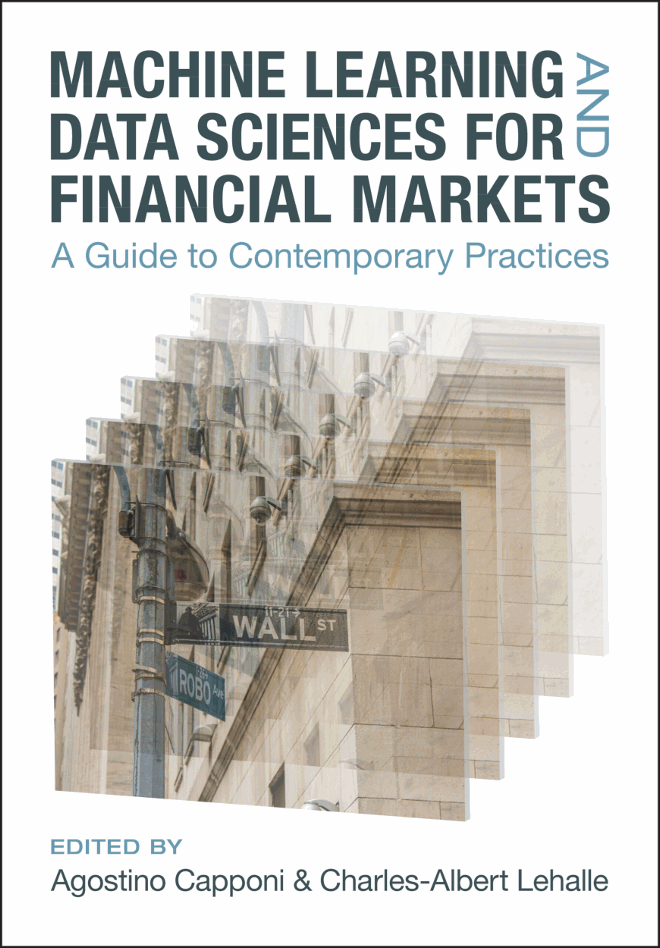
© 2023, Cambridge University Press
“Machine Learning and Data Sciences for Financial Markets”, edited by Agostino Capponi and Charles-Albert Lehalle, covers the very popular topics of machine learning, data science, artificial intelligence and their applications in various areas of financial engineering. These techniques, developed primarily in computer science, have enormous implications for the study and operation of financial markets.
The book is timely and provides a broad overview of the emerging literature. It brings together an impressive line-up of renowned researchers in quantitative finance. The editors have succeeded in structuring and integrating the very diverse contributions into an encyclopaedic volume.
The book consists of seven chapters, each preceded by a foreword by a dedicated scholar that introduces and summarizes the four to six subchapters written by individual (teams of) authors that make up the content of that chapter.
Chapter 1 provides an introduction to robo-advisors. These are generally defined as technological platforms that help individuals make better financial decisions. They provide advice on a large scale and use large data sets. The meaning of the term “advice" is deliberately broad to include investment, consumption and financial planning, while the prefix “robo" expresses that the advice is based on smart rules and algorithms. The subchapters focus on household finance, explainable AI in robo-advising, the principles and operation of robo-advising algorithms, and recommender systems for bond trading.
Chapter 2 deals with price formation and price discovery based on order flows. Specifically, the subchapters deal with the theoretical analysis and modelling of price formation on exchanges with limit order books, and an introduction and in-depth stochastic analysis of the classical Kyle model and its connection to the Glosten-Milgrom model. Both are cornerstones of market microstructure models in the financial economics literature. In a more practice-oriented subchapter, four types of market participants are modelled, extending the binary notion of informed and uninformed traders.
Chapter 3 addresses reinforcement learning for algorithmic trading. It critically discusses the range and limitations of problems that can be addressed with reinforcement learning, and reminds us of the obvious fact that finance is not a simple, repeated game. This discussion is accompanied by a self-contained introduction to reinforcement learning, which takes Markov decision processes as its starting point. Two further subchapters deal with finding extrema of functions that can only be computed as the expected value of more complex functions, and with a detailed construction of a reinforcement learning strategy in foreign exchange markets.
Chapter 4 discusses one of the major challenges to the use of deep learning models in finance, namely the curse of overfitting to small historical data on the one hand and the insatiable need of such methods for training data on the other hand. One remedy to the latter is the use of simulated data, which again poses a model risk. It seems inevitable to choose between the body and tails of the generated distributions. An alternative is the stratified modelling approach, which addresses the problem of overfitting. Another alternative presented is the use of no-arbitrage constraints to regularize deep learning models for asset pricing.
Chapter 5 presents six key contributions on the interplay between deep learning and stochastic control problems in finance. This is preceded by a brief history of machine learning in applied mathematics and finance with many anecdotal short stories. Mean field games are introduced to study equilibria in large games with complex structures. Deep learning techniques combined with reinforcement learning are successfully used to solve nonlinear PDEs in high dimensions. A critical review raises questions about the performance and training of generative adversarial networks. This is an important aspect that is often neglected amidst the hype surrounding these methods.
Chapter 6 connects machine learning to real-world economics. This chapter is about data science. Specifically, it is about nowcasting microeconomic and macroeconomic information. The underlying idea is that better and more timely information is beneficial in economics and investment. Subchapters cover a variety of topics, including the CEO dashboard - a nowcast view of current business conditions, alternative data that is large, high-dimensional, and unstructured, and natural language processing mathematics and its applications in finance.
Chapter 7 addresses model risk, model complexity, and the trade-off between purely data-based and model-based approaches to solving problems and tasks in financial engineering. Subchapters develop a measure of model complexity, a Bayesian approach to factor models in asset pricing, and a systematic discussion of the various sources of black-box model risk in finance.
Written by leading data scientists, AI research leaders, business executives and leaders of brokerage and investment firms and hedge funds, and some of the most renowned scholars in the field, the book contains a wealth of timely and relevant insights on the subject.
Any such collection of contributions is bound up with bias and a certain amount of randomness. Overall, the editors have succeeded in integrating them into a coherent volume. The main structure is oriented around the seven chapters, which are more or less independent of each other.
Overall, this is not a book that you read linearly from beginning to end. You read it when you come across one of the topics on an ad hoc basis, or to get inspiration for new research directions. Graduate students, senior researchers, and practitioners alike will use it as a guide and handbook for introducing selected topics in machine learning and AI in quantitative finance and as further reading.
Additional information
Notes on contributors
Damir Filipovic
Damir Filipovic holds the Swissquote Chair in Quantitative Finance at the Ecole Polytechnique Fédérale de Lausanne (EPFL) and a Swiss Finance Institute Senior Chair.
